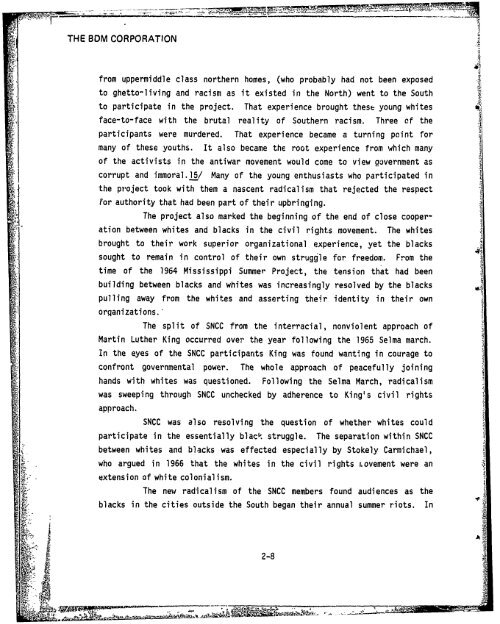policy - The Black Vault
policy - The Black Vault
policy - The Black Vault
You also want an ePaper? Increase the reach of your titles
YUMPU automatically turns print PDFs into web optimized ePapers that Google loves.
THE BDM CORPORATION<br />
from uppermiddle class northern homes, (who probably had not been exposed<br />
to ghetto-living and racism as it existed in the North) went to the South<br />
to participate in the project.<br />
That experience brought these young whites<br />
face-to-face with the brutal reality of Southern racism. Three of the<br />
participants were murdered. That experience became a turning point for<br />
many of these youths. It also became the root experience from which many<br />
of the activists in the antiwar movement would come to view government as<br />
corrupt and immoral.15/<br />
Many of the young enthusiasts who participated in<br />
the project took with them a nascent radicalism that rejected the respect<br />
for authority that had been part of their upbringing.<br />
<strong>The</strong> project also marked the beginning of the end of close cooper-<br />
"ation between whites and blacks in the civil rights movement.<br />
<strong>The</strong> whites<br />
brought to their work superior organizational experience, yet the blacks<br />
sought to remain in control of their own struggle for freedom.<br />
From the<br />
time of the 1964 Mississippi Summer Project, the tension that had been<br />
building between blacks and whites was increasingly resolved by the blacks<br />
pulling away<br />
orqanizations.<br />
from the whites and asserting their identity in their own<br />
<strong>The</strong> split of SNCC<br />
from the interracial, nonviolent approach of<br />
Martin Luther King occurred over the year following the 1965 Selma march.<br />
In the eyes of the SNCC participants King was found wanting in courage to<br />
confront governmental power. <strong>The</strong> whole approach of peacefully joining<br />
hands with whites was questioned. Following the Selma March, radicalism<br />
was sweeping through SNCC<br />
approach.<br />
unchecked by adherence to King's civil rights<br />
SNCC was also resolving the question of whether whites could<br />
participate in the essentially black struggle.<br />
<strong>The</strong> separation within SNCC<br />
between whites and blacks was effected especially by Stokely Carmichael,<br />
who<br />
argued in 1966 that the whites in the civil rights r.ovement were an<br />
extension of white colonialism.<br />
<strong>The</strong> new radicalism of the SNCC members found audiences as the<br />
blacks in the cities outside the South began their annual summer riots. In<br />
2-8<br />
W~'. 14
















